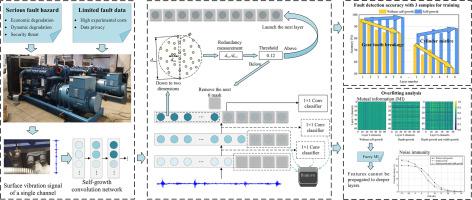利用非常有限的发动机数据进行热故障和机械故障检测的自生长卷积网络
IF 9.6
Q1 COMPUTER SCIENCE, ARTIFICIAL INTELLIGENCE
引用次数: 0
摘要
严重故障不常发生,但对电力机械的预报和健康管理(PHM)至关重要。由于故障数据稀缺,诊断模型始终面临着数据非常有限的问题。基本的卷积神经网络需要大量样本进行训练,而广泛使用的数据增强方法会受到数据质量的影响,从而加剧过拟合。为了解决这个问题,我们提出了一种自增长卷积网络(SGNet),使深度学习过程在深度和宽度维度上都成为一种自增长方案。在逐层训练过程中,利用直接相似度测量来监督深度增长。利用特征冗余度量来控制宽度扩展。为了减少小样本情况下的过拟合问题,提出了自生长方案来破坏层与层之间以及内核与内核之间的协同适应。SGNet 在重型柴油发动机的 PHM 中得到了验证和实施。它在样本极其有限的情况下表现出卓越的诊断能力。在每个故障类型只有三个训练样本的情况下,SGNet 对失火故障和轮齿断裂故障的识别率分别为 88.44% 和 98.11%。此外,还通过烧蚀实验详细讨论了 SGNet 的特征对比、信息传递、抗噪能力和频域激活热。这些结果为解决重要动力机械 PHM 中的数据限制问题指明了一条新路。本文章由计算机程序翻译,如有差异,请以英文原文为准。

A self-growth convolution network for thermal and mechanical fault detection with very limited engine data
Severe faults occur infrequently but are critical for the prognostics and health management (PHM) of power machinery. Due to the scarcity of fault data, diagnostic models are always facing a very limited data problem. Basic convolutional neural networks require a large number of samples to train, and widely used data augmentation methods are influenced by data quality, which can exacerbate overfitting. To address this issue, a self-growth convolution network (SGNet) is proposed to make the deep learning process a self-growing scheme in both depth and width dimensions. The direct similarity measurement is utilized to supervise the depth-growth in the layer-by-layer training process. The feature redundancy metric is employed to control the width expansion. The self-growth scheme is proposed to disrupt the coadaptation between layers and that between kernels in order to mitigate the overfitting issue of small-sample cases. The SGNet is verified and implemented in the PHM of a heavy-duty diesel engine. It exhibits remarkable diagnostic capabilities in extremely sample-limited scenarios. With only three training samples per faulty type, the recognition rates of SGNet for the misfire fault and the gear tooth fracture fault are 88.44% and 98.11%, respectively. Further, the feature contrast, the information transmission, the noise resistance, and the frequency domain activation heat of SGNet are discussed by the ablation experiment in detail. The results indicate a novel path to solve the data-limitation problem in the PHM of important power machinery.
求助全文
通过发布文献求助,成功后即可免费获取论文全文。
去求助
来源期刊

Energy and AI
Engineering-Engineering (miscellaneous)
CiteScore
16.50
自引率
0.00%
发文量
64
审稿时长
56 days
 求助内容:
求助内容: 应助结果提醒方式:
应助结果提醒方式:


